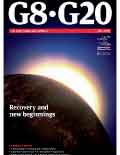

 |
 |
|

Building effective humanitarian responses
for the 21st century
By Sir John Holmes, United Nations undersecretary general for humanitarian affairs and emergency relief coordinator
To download a low-resolution pdf, click here or go to the Newsdesk site.
Coping with and preparing for the hazards caused by climate change are responsibilities that must be shared by all
The rapid and effective response to the Haiti earthquake in January 2010 was possible only because everyone in the humanitarian community worked together in ways unimaginable a decade ago, or even five years ago when the Asian tsunami hit. We must now deepen and widen those partnerships in the months and years ahead in the face of increasing challenges. The G8 and G20 countries are well placed to help drive this process forward.
Profound global changes are increasing needs and vulnerability and shaping the humanitarian landscape in new ways. Climate change is already increasing the frequency and intensity of extreme natural hazard events, particularly floods, storms and droughts. The global food crisis is not over in many poor developing countries and will worsen over time. There is also continuing rapid population growth in many poor countries with demographic shifts and growing urbanisation causing many more people to live in high-risk areas. Land, water and energy scarcities are increasing, as are disturbances to key ecosystems, the risks of pandemics and, in the shorter term, the impact of the current global economic crisis on the poorest and most vulnerable.
Individually, these so-called mega trends are likely to drive up humanitarian needs by creating more poverty and vulnerability, greater levels of inequality, higher unemployment, increased frequency and intensity of disasters, new kinds of conflicts and major weather-driven migrations. Combined, they threaten to create chronic vulnerability on a scale not readily imaginable now.
The good news is that this situation is increasingly recognised. Countries, regional organisations, United Nations agencies, non-governmental organisations (NGOs), the International Red Cross and Red Crescent Movement and many others are using improved systems to make this diversity work for the world. These organisations have started to put in place a humanitarian architecture that can help the world cope: stronger humanitarian coordinators, humanitarian country teams, clusters for coordination and quicker and more equitable collective funding tools. The generosity of donors, be they governments, individuals, companies or foundations, has improved. The most urgent humanitarian needs are usually funded, although a huge amount are not.
But the world needs to reflect further on how to respond to chronic vulnerability and determine how humanitarians can work best in a world where humanitarian response can no longer be easily defined by the triggers of major natural disasters or human-made conflict. A rethink of the traditional model for saving lives with humanitarian assistance is urgently needed because in the face of new threats, the humanitarian toolbox is often insufficient to change the situation. The role of the international organisations is to support governments by filling in gaps of capacity and resources where they are asked to do so and where they can remain relevant – and are needed now more than ever. But, given the scale of the challenges ahead, the world also needs new ways of working in order to stem the immense human suffering, mass migration, pandemics and resource-based conflicts that could otherwise be overwhelming.
A new model should emphasise prevention and risk reduction at least as much as response. This model would shift the focus toward increasing national and regional preparedness and response capacity, to improve rapid and culturally sensitive action at all stages of the crisis cycle. For example, new partnerships are needed among public authorities, civil society and business actors focused on building preparedness and resilience at every level, from the village or town to the district and the country, as well as at the regional level.
What might such partnerships do? In the first place, partners would work together at building resilience against natural hazards such as floods, earthquakes and drought through early warning systems, water management schemes, reforestation, relocation of communities away from disaster-prone places, and so on. But there is also a need for a broader look at what makes communities able to cope with the extra sudden shocks likely to become the pattern of the future. The idea is not to dictate a particular model, but to put the key actors together and generate new ways of working.
Making this change will require significant political will and determination on the part of all involved. That is where G8 and G20 countries can come in. Donor countries need to fund disaster risk reduction and preparedness measures. Adaptation to climate change has to include investing in systems for disaster reduction, preparedness and management.
But, ultimately, this needs to happen not through some top-down process, but through systematic engagement at all levels, particularly from the bottom up. It needs to become the natural way of working together, given today’s new challenges. And while it is perhaps most needed in vulnerable developing countries, and for the most vulnerable populations, the model is equally applicable to developed countries – and indeed already exists in some.
There is already a head start on reducing disaster. The Hyogo Framework for Action gives a global blueprint for 2005-15 to help governments and organisations assess and reduce risks through planning, training and public education. Examples include making investments that preempt potential future costs of disasters and making sure that schools, hospitals and other key public infrastructure meet certain safety standards. Some 168 governments signed Hyogo in 2005, but many have failed to follow through on the practical measures it proposes.
When it comes to responding to the needs arising from chronic vulnerability rather than those caused by a one-off event – a major natural disaster or human-made conflict – the world also needs to reshape radically its understanding of humanitarian versus development action. Who takes responsibility when there are new and additional humanitarian caseloads in supposedly developmental contexts? What capacities are needed? Where will the money come from? These questions cannot be dodged.
Strategies, both developmental and humanitarian, need to favour resilience to the multiple threats that loom, with national and local authorities and partners on the ground in the lead wherever possible.
Today’s problems respect no boundaries and do not fit the model of the crises that have faced the world in the past. We must shape our future practices accordingly. It is no longer enough to see the UN humanitarian agencies, and the humanitarian community at large, just as a sort of international fire brigade, turning up wherever the flames get too high. While the fire brigade will certainly still be needed, and perhaps more than ever in future years – because of extra disasters caused by climate change and because major disasters like the Haiti earthquake can never be stopped – the focus needs to shift fundamentally toward building local, national and regional capacity to deal with these problems and toward prevention, preparedness and disaster risk reduction before disaster and crises strike.
|
This Information System is provided by the University of Toronto Library |
All contents copyright © 2024. University of Toronto unless otherwise stated. All rights reserved.